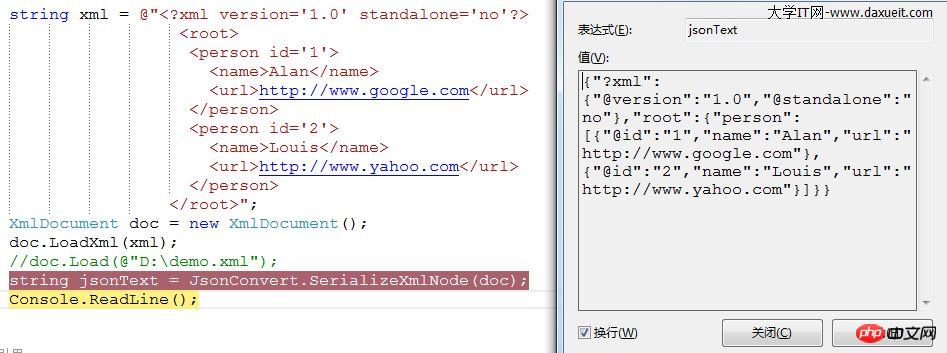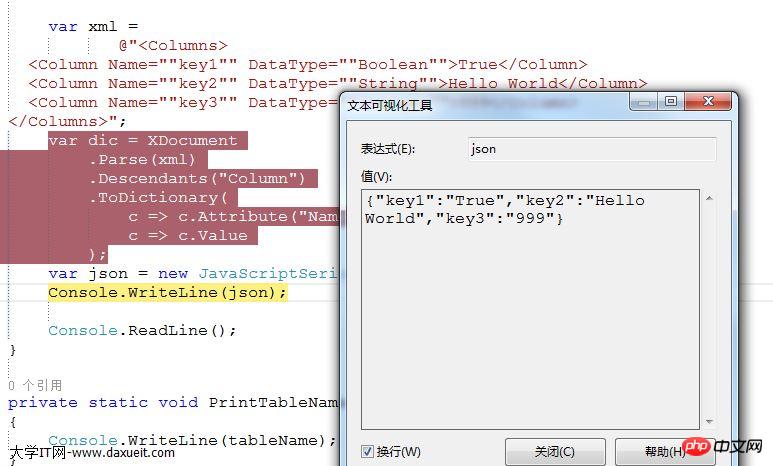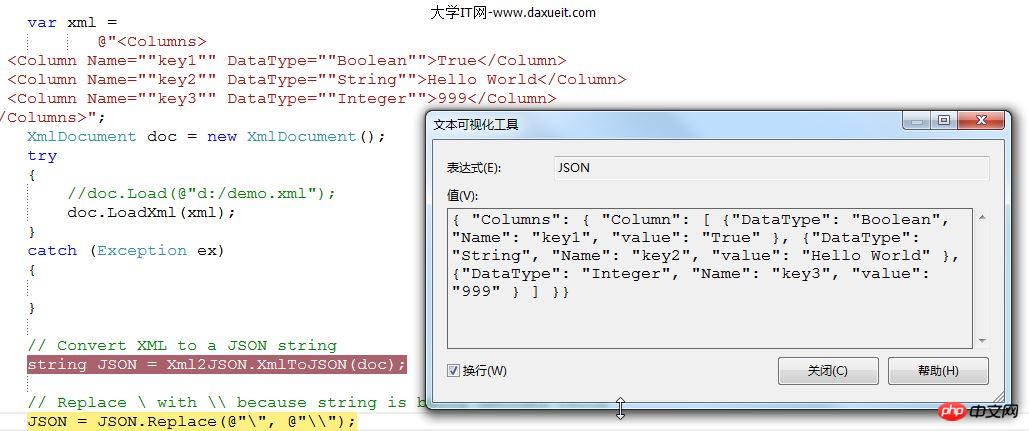 Backend Development
Backend Development
 XML/RSS Tutorial
XML/RSS Tutorial
 Detailed introduction to the conversion between XML and JSON (graphics and text)
Detailed introduction to the conversion between XML and JSON (graphics and text)
Detailed introduction to the conversion between XML and JSON (graphics and text)
JOSN简介
在本系列的第一篇已经简单比较了XML和JSON 时光机
JSON:JavaScript 对象表示法(JavaScript Object Notation)。 JSON 是存储和交换文本信息的语法。类似 XML。 JSON 比 XML 更小、更快,更易解析。
什么是 JSON?
JSON 指的是 JavaScript 对象表示法(JavaScript Object Notation) JSON 是轻量级的文本数据交换格式 JSON 独立于语言 * JSON 具有自我描述性,更易理解
JSON 使用 JavaScript 语法来描述数据对象,但是 JSON 仍然独立于语言和平台。JSON 解析器和 JSON 库支持许多不同的编程语言。
JSON格式化
尽管有许多宣传关于 XML 如何拥有跨平台,跨语言的优势,然而,除非应用于 Web Services,否则,在普通的 Web 应用中,开发者经常为 XML 的解析伤透了脑筋,无论是服务器端生成或处理 XML,还是客户端用 JavaScript 解析 XML,都常常导致复杂的代码,极低的开发效率。实际上,对于大多数 Web 应用来说,他们根本不需要复杂的 XML 来传输数据,XML 的扩展性很少具有优势,许多 AJAX 应用甚至直接返回 HTML 片段来构建动态 Web 页面。和返回 XML 并解析它相比,返回 HTML 片段大大降低了系统的复杂性,但同时缺少了一定的灵活性
XML2JOSN
借助第三方类库转换

使用NuGet添加第三方类库

<code>string xml = @"<?xml version='1.0' standalone='no'?>
<root>
<person id='1'>
<name>Alan</name>
<url>http://www.google.com</url>
</person>
<person id='2'>
<name>Louis</name>
<url>http://www.yahoo.com</url>
</person>
</root>";
XmlDocument doc = new XmlDocument();
doc.LoadXml(xml);
string jsonText = JsonConvert.SerializeXmlNode(doc);
//{
// "?xml": {
// "@version": "1.0",
// "@standalone": "no"
// },
// "root": {
// "person": [
// {
// "@id": "1",
// "name": "Alan",
// "url": "http://www.google.com"
// },
// {
// "@id": "2",
// "name": "Louis",
// "url": "http://www.yahoo.com"
// }
// ]
// }
//}</code>
对于每个表标签的属性对应JSON中的"@"标签名
如果有多个同名标签就会添加到一个数组集合中
其他方式转换
1.使用.NET Framework中的JavaScriptSerializer类
首先需要确保你的工程或服务器支持.NET 4.0或以上版本的Framework,否则无法找到该类。
通过JavaScriptSerializer来实现。它的名字空间为:System.Web.Script.Serialization
如果要使用它,还须添加
System.Web.Extensions库文件引用
<code> var xml =
@"<Columns>
<Column Name=""key1"" DataType=""Boolean"">True</Column>
<Column Name=""key2"" DataType=""String"">Hello World</Column>
<Column Name=""key3"" DataType=""Integer"">999</Column>
</Columns>";
var dic = XDocument
.Parse(xml)
.Descendants("Column")
.ToDictionary(
c => c.Attribute("Name").Value,
c => c.Value
);
var json = new JavaScriptSerializer().Serialize(dic);
Console.WriteLine(json);</code>
2.手动编写转换类
<code> public class Xml2JSON
{
public static string XmlToJSON(XmlDocument xmlDoc)
{
StringBuilder sbJSON = new StringBuilder();
sbJSON.Append("{ ");
XmlToJSONnode(sbJSON, xmlDoc.DocumentElement, true);
sbJSON.Append("}");
return sbJSON.ToString();
}
// XmlToJSONnode: Output an XmlElement, possibly as part of a higher array
private static void XmlToJSONnode(StringBuilder sbJSON, XmlElement node, bool showNodeName)
{
if (showNodeName)
sbJSON.Append("\"" + SafeJSON(node.Name) + "\": ");
sbJSON.Append("{");
// Build a sorted list of key-value pairs
// where key is case-sensitive nodeName
// value is an ArrayList of string or XmlElement
// so that we know whether the nodeName is an array or not.
SortedList childNodeNames = new SortedList();
// Add in all node attributes
if (node.Attributes != null)
foreach (XmlAttribute attr in node.Attributes)
StoreChildNode(childNodeNames, attr.Name, attr.InnerText);
// Add in all nodes
foreach (XmlNode cnode in node.ChildNodes)
{
if (cnode is XmlText)
StoreChildNode(childNodeNames, "value", cnode.InnerText);
else if (cnode is XmlElement)
StoreChildNode(childNodeNames, cnode.Name, cnode);
}
// Now output all stored info
foreach (string childname in childNodeNames.Keys)
{
ArrayList alChild = (ArrayList)childNodeNames[childname];
if (alChild.Count == 1)
OutputNode(childname, alChild[0], sbJSON, true);
else
{
sbJSON.Append(" \"" + SafeJSON(childname) + "\": [ ");
foreach (object Child in alChild)
OutputNode(childname, Child, sbJSON, false);
sbJSON.Remove(sbJSON.Length - 2, 2);
sbJSON.Append(" ], ");
}
}
sbJSON.Remove(sbJSON.Length - 2, 2);
sbJSON.Append(" }");
}
// StoreChildNode: Store data associated with each nodeName
// so that we know whether the nodeName is an array or not.
private static void StoreChildNode(SortedList childNodeNames, string nodeName, object nodeValue)
{
// Pre-process contraction of XmlElement-s
if (nodeValue is XmlElement)
{
// Convert <aa></aa> into "aa":null
// <aa>xx</aa> into "aa":"xx"
XmlNode cnode = (XmlNode)nodeValue;
if (cnode.Attributes.Count == 0)
{
XmlNodeList children = cnode.ChildNodes;
if (children.Count == 0)
nodeValue = null;
else if (children.Count == 1 && (children[0] is XmlText))
nodeValue = ((XmlText)(children[0])).InnerText;
}
}
// Add nodeValue to ArrayList associated with each nodeName
// If nodeName doesn't exist then add it
object oValuesAL = childNodeNames[nodeName];
ArrayList ValuesAL;
if (oValuesAL == null)
{
ValuesAL = new ArrayList();
childNodeNames[nodeName] = ValuesAL;
}
else
ValuesAL = (ArrayList)oValuesAL;
ValuesAL.Add(nodeValue);
}
private static void OutputNode(string childname, object alChild, StringBuilder sbJSON, bool showNodeName)
{
if (alChild == null)
{
if (showNodeName)
sbJSON.Append("\"" + SafeJSON(childname) + "\": ");
sbJSON.Append("null");
}
else if (alChild is string)
{
if (showNodeName)
sbJSON.Append("\"" + SafeJSON(childname) + "\": ");
string sChild = (string)alChild;
sChild = sChild.Trim();
sbJSON.Append("\"" + SafeJSON(sChild) + "\"");
}
else
XmlToJSONnode(sbJSON, (XmlElement)alChild, showNodeName);
sbJSON.Append(", ");
}
// Make a string safe for JSON
private static string SafeJSON(string sIn)
{
StringBuilder sbOut = new StringBuilder(sIn.Length);
foreach (char ch in sIn)
{
if (Char.IsControl(ch) || ch == '\'')
{
int ich = (int)ch;
sbOut.Append(@"\u" + ich.ToString("x4"));
continue;
}
else if (ch == '\"' || ch == '\\' || ch == '/')
{
sbOut.Append('\\');
}
sbOut.Append(ch);
}
return sbOut.ToString();
}
}</code>
JOSN2XML
借助第三方类库转换

<code>string json = @"{
'?xml': {
'@version': '1.0',
'@standalone': 'no'
},
'root': {
'person': [
{
'@id': '1',
'name': 'Alan',
'url': 'http://www.google.com'
},
{
'@id': '2',
'name': 'Louis',
'url': 'http://www.yahoo.com'
}
]
}
}";
XmlDocument doc = JsonConvert.DeserializeXmlNode(json);
doc.Save(@"D:\json.xml");
// <?xml version="1.0" standalone="no"?>
// <root>
// <person id="1">
// <name>Alan</name>
// <url>http://www.google.com</url>
// </person>
// <person id="2">
// <name>Louis</name>
// <url>http://www.yahoo.com</url>
// </person>
// </root></code>其他方式转换

The above is the detailed content of Detailed introduction to the conversion between XML and JSON (graphics and text). For more information, please follow other related articles on the PHP Chinese website!

Hot AI Tools

Undresser.AI Undress
AI-powered app for creating realistic nude photos

AI Clothes Remover
Online AI tool for removing clothes from photos.

Undress AI Tool
Undress images for free

Clothoff.io
AI clothes remover

AI Hentai Generator
Generate AI Hentai for free.

Hot Article

Hot Tools

Notepad++7.3.1
Easy-to-use and free code editor

SublimeText3 Chinese version
Chinese version, very easy to use

Zend Studio 13.0.1
Powerful PHP integrated development environment

Dreamweaver CS6
Visual web development tools

SublimeText3 Mac version
God-level code editing software (SublimeText3)

Hot Topics
 1385
1385
 52
52
 Can I open an XML file using PowerPoint?
Feb 19, 2024 pm 09:06 PM
Can I open an XML file using PowerPoint?
Feb 19, 2024 pm 09:06 PM
Can XML files be opened with PPT? XML, Extensible Markup Language (Extensible Markup Language), is a universal markup language that is widely used in data exchange and data storage. Compared with HTML, XML is more flexible and can define its own tags and data structures, making the storage and exchange of data more convenient and unified. PPT, or PowerPoint, is a software developed by Microsoft for creating presentations. It provides a comprehensive way of
 What is the difference between MySQL5.7 and MySQL8.0?
Feb 19, 2024 am 11:21 AM
What is the difference between MySQL5.7 and MySQL8.0?
Feb 19, 2024 am 11:21 AM
MySQL5.7 and MySQL8.0 are two different MySQL database versions. There are some main differences between them: Performance improvements: MySQL8.0 has some performance improvements compared to MySQL5.7. These include better query optimizers, more efficient query execution plan generation, better indexing algorithms and parallel queries, etc. These improvements can improve query performance and overall system performance. JSON support: MySQL 8.0 introduces native support for JSON data type, including storage, query and indexing of JSON data. This makes processing and manipulating JSON data in MySQL more convenient and efficient. Transaction features: MySQL8.0 introduces some new transaction features, such as atomic
 Performance optimization tips for converting PHP arrays to JSON
May 04, 2024 pm 06:15 PM
Performance optimization tips for converting PHP arrays to JSON
May 04, 2024 pm 06:15 PM
Performance optimization methods for converting PHP arrays to JSON include: using JSON extensions and the json_encode() function; adding the JSON_UNESCAPED_UNICODE option to avoid character escaping; using buffers to improve loop encoding performance; caching JSON encoding results; and considering using a third-party JSON encoding library.
 Pandas usage tutorial: Quick start for reading JSON files
Jan 13, 2024 am 10:15 AM
Pandas usage tutorial: Quick start for reading JSON files
Jan 13, 2024 am 10:15 AM
Quick Start: Pandas method of reading JSON files, specific code examples are required Introduction: In the field of data analysis and data science, Pandas is one of the important Python libraries. It provides rich functions and flexible data structures, and can easily process and analyze various data. In practical applications, we often encounter situations where we need to read JSON files. This article will introduce how to use Pandas to read JSON files, and attach specific code examples. 1. Installation of Pandas
 How do annotations in the Jackson library control JSON serialization and deserialization?
May 06, 2024 pm 10:09 PM
How do annotations in the Jackson library control JSON serialization and deserialization?
May 06, 2024 pm 10:09 PM
Annotations in the Jackson library control JSON serialization and deserialization: Serialization: @JsonIgnore: Ignore the property @JsonProperty: Specify the name @JsonGetter: Use the get method @JsonSetter: Use the set method Deserialization: @JsonIgnoreProperties: Ignore the property @ JsonProperty: Specify name @JsonCreator: Use constructor @JsonDeserialize: Custom logic
 In-depth understanding of PHP: Implementation method of converting JSON Unicode to Chinese
Mar 05, 2024 pm 02:48 PM
In-depth understanding of PHP: Implementation method of converting JSON Unicode to Chinese
Mar 05, 2024 pm 02:48 PM
In-depth understanding of PHP: Implementation method of converting JSONUnicode to Chinese During development, we often encounter situations where we need to process JSON data, and Unicode encoding in JSON will cause us some problems in some scenarios, especially when Unicode needs to be converted When encoding is converted to Chinese characters. In PHP, there are some methods that can help us achieve this conversion process. A common method will be introduced below and specific code examples will be provided. First, let us first understand the Un in JSON
 How to use PHP functions to process XML data?
May 05, 2024 am 09:15 AM
How to use PHP functions to process XML data?
May 05, 2024 am 09:15 AM
Use PHPXML functions to process XML data: Parse XML data: simplexml_load_file() and simplexml_load_string() load XML files or strings. Access XML data: Use the properties and methods of the SimpleXML object to obtain element names, attribute values, and subelements. Modify XML data: add new elements and attributes using the addChild() and addAttribute() methods. Serialized XML data: The asXML() method converts a SimpleXML object into an XML string. Practical example: parse product feed XML, extract product information, transform and store it into a database.
 Quick tips for converting PHP arrays to JSON
May 03, 2024 pm 06:33 PM
Quick tips for converting PHP arrays to JSON
May 03, 2024 pm 06:33 PM
PHP arrays can be converted to JSON strings through the json_encode() function (for example: $json=json_encode($array);), and conversely, the json_decode() function can be used to convert from JSON to arrays ($array=json_decode($json);) . Other tips include avoiding deep conversions, specifying custom options, and using third-party libraries.



